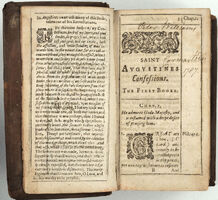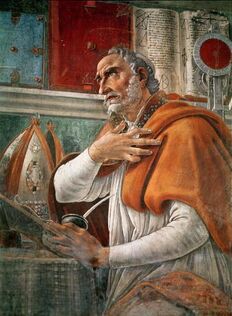Saint Augustine’s Confession is a combination of autobiography, philosophy, theology and critical interp

retation of the Holy Bible. First nine books are the autobiography from his childhood to his conversion to Catholicism and the last four books deal with religious and philosophical topics. Book X is about memory, Book XI about time and eternity, and Book XII and XIII is an interpretation of the Book of Genesis. The recurring theme of his work is redemption. The work is aim to bring back the creation of God and to inspire others to support this return. A confession in Augustine’s time means both knowing the guilt and praise God.
Saint Augustine of Hippo[]

Saint Augustine in His Study by Sandro Botticelli, 1480, Chiesa di Ognissanti, Florence, Italy
- Saint Augustine’s Confession is a combination of autobiography, philosophy, theology and critical interpretation of the Holy Bible. First nine books are the autobiography from his childhood to his conversion to Catholicism and the last four books deal with religious and philosophical topics. Book X is about memory, Book XI about time and
eternity, and Book XII and XIII is an interpretation of the Book of Genesis. The recurring theme of his work is redemption. The work is aim to bring back the creation of God and to inspire others to support this return. A confession in Augustine’s time means both knowing the guilt and praise God.
Allusions in The Waste Land[]
Line 307- 311
“To Carthage then I came
Burning burning burning burning
O Lord Thou pluckest me out
O Lord Thou pluckest
burning.”
- Carthage and referenced to Augustine’s journey to overcome his secular life and abandon the pagan world. O Lord Thou pluckest me out is in the Book X of Augustine’s Confession. Burning burning burning burning is an allusion to the Buddhist “ Fire Sermon,” in which Buddha preaches about abandoning the fire of lust and other passions that destroy people. Both Buddha and Augustine warn against the physical urges as prevent people from achieving higher lives and freedom. According to T.S. Eliot, the reason for having both these two characters is to represent the Western and Eastern ascetism. The next section of the poem, "Death by Water," in which there is no ressurection after death, Eliot somewhat mocks these two individual's faith in a higher power. The last "burning" was meant to say that all struggle in life is futile, and eventually leads to death.